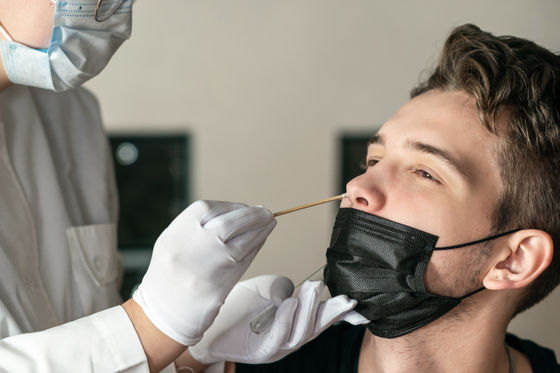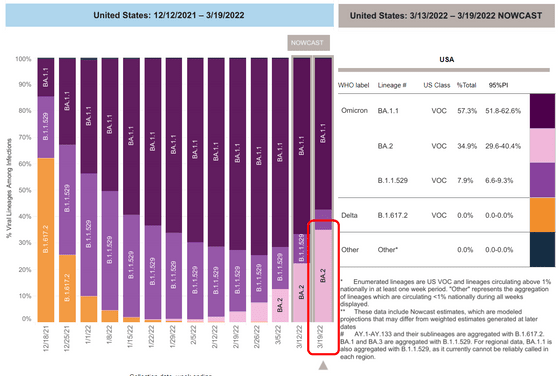Experts answer questions about the Omicron strain subtype 'BA.2' called 'stealth type'

The subtype 'BA.2', which is further derived from the Omicron strain of the new coronavirus, is rapidly becoming the predominant mutant strain with an increasing number of patients around the world. An immunological scholar explained 'BA.2', which is sometimes called 'stealth type'.
What is the new COVID-19 variant BA.2, and will it cause another wave of infections in the US?
◆ Three subtypes of Omicron strain
According to Prakash Nagarkatti, Senior Research Advisor to the President of the University of South Carolina, and Mitzi Nagarkatti, a professor of immunology at the University of South Carolina, the Omicron strains of the new coronavirus have been 'BA.1', 'BA.2' and 'BA.2'. It is said that three major subtypes of 'BA.3' have been found.
Of these, the earliest found Omicron strain 'BA.1' is characterized by many mutations from the new coronavirus wild strain found in Wuhan, China, especially for the spike protein used for cell invasion. There are more mutations. And while 'BA.2' has eight more mutations that 'BA.1' does not have, 13 mutations in 'BA.1' are missing. Overall, 'BA.2' shares about 30 mutations with 'BA.1', so its genetic similarity has identified it as a subtype of the Omicron strain rather than a new mutant. rice field.
◆ Why is it called 'stealth type'?
Some researchers call 'BA.2' a 'stealth type'. This is because it is difficult to identify it as an Omicron strain because it does not have important genetic characteristics to distinguish it from the Delta strain. Due to this property, it is possible to detect 'BA.2' by a standard PCR test, but it may not be possible to determine whether it is a delta strain or an omicron strain.

◆ Is it true that it is more infectious and deadly than other mutant strains?
According to Nagarkatti et al., 'BA.2' is thought to be more infectious than the first found Omicron strain 'BA.1', but it is not very toxic. In other words, 'BA.2' may spread more rapidly than 'BA.1', but it may be less likely to make a person sick.
However, (PDF file) Recent reports in the
In addition, research results have been reported that 'BA.2' has the infectivity and anti-vaccine properties of the Omicron strain, as well as the aggravation rate of the Delta strain.
Research results show that the derivative strain of Omicron strain 'BA.2' has both the aggravation rate of Delta strain and the infectivity and anti-vaccine property of Omicron strain --GIGAZINE

◆ What if I had Omicron strains in the past?
Previous studies have suggested that people with a history of 'BA.1' infection have strong protection against 'BA.2'. Since the 'BA.1' Omicron strain raged all over the world, it is thought that many people have immunity to 'BA.2'. For this reason, some scientists predict that 'BA.2' is unlikely to lead to a new pandemic.
However, Nagarkatti et al. 'Although the innate immunity gained from past infections is highly effective against reinfection of early mutant strains, it is less effective against Omicron strains,' optimistically. He showed a cautious attitude that he could not see.
◆ What is the effect of the vaccine?
In a preliminary study conducted in more than 1 million people in Qatar, two doses of Pfizer and Moderna vaccines provide protection against symptomatic infections of BA.1 and BA.2 for approximately 3 months. However, the protection rate has dropped to about 10% in 4 to 6 months. However, the booster dose of the third dose again increased the protection rate to its original level.

'The important thing is that vaccination prevented hospitalizations and deaths by 70% to 80%, and increased to more than 90% after booster vaccination,' said Nagarkatti and colleagues. He pointed out that although the infection prevention effect declines relatively early, it is still important that the risk of aggravation and death is greatly reduced.
◆ How much do you need to worry about 'BA.2'?
According to data from the Centers for Disease Control and Prevention, the number of people infected with 'BA.2' is steadily increasing, and as of mid-March, about 30% of people infected with 'BA.2' are 'BA.2'. .. It is thought that the background to the epidemic of 'BA.2' is a combination of factors such as high infectivity, weakened immunity of people, and deregulation of infectious disease control.

Regarding the future outlook for the spread of 'BA.2', Nagarkatti et al. 'Whether a catastrophic outbreak will occur again, how many people are vaccinated, and in the past,'BA It depends on whether you have been infected with .1 ”. In particular, it is safer to make immunity with a vaccine, so you should receive two vaccinations and a booster vaccination, wear an N95 mask, and increase the distance. It's best to take precautionary measures. '
Related Posts:
in Science, Posted by log1l_ks







